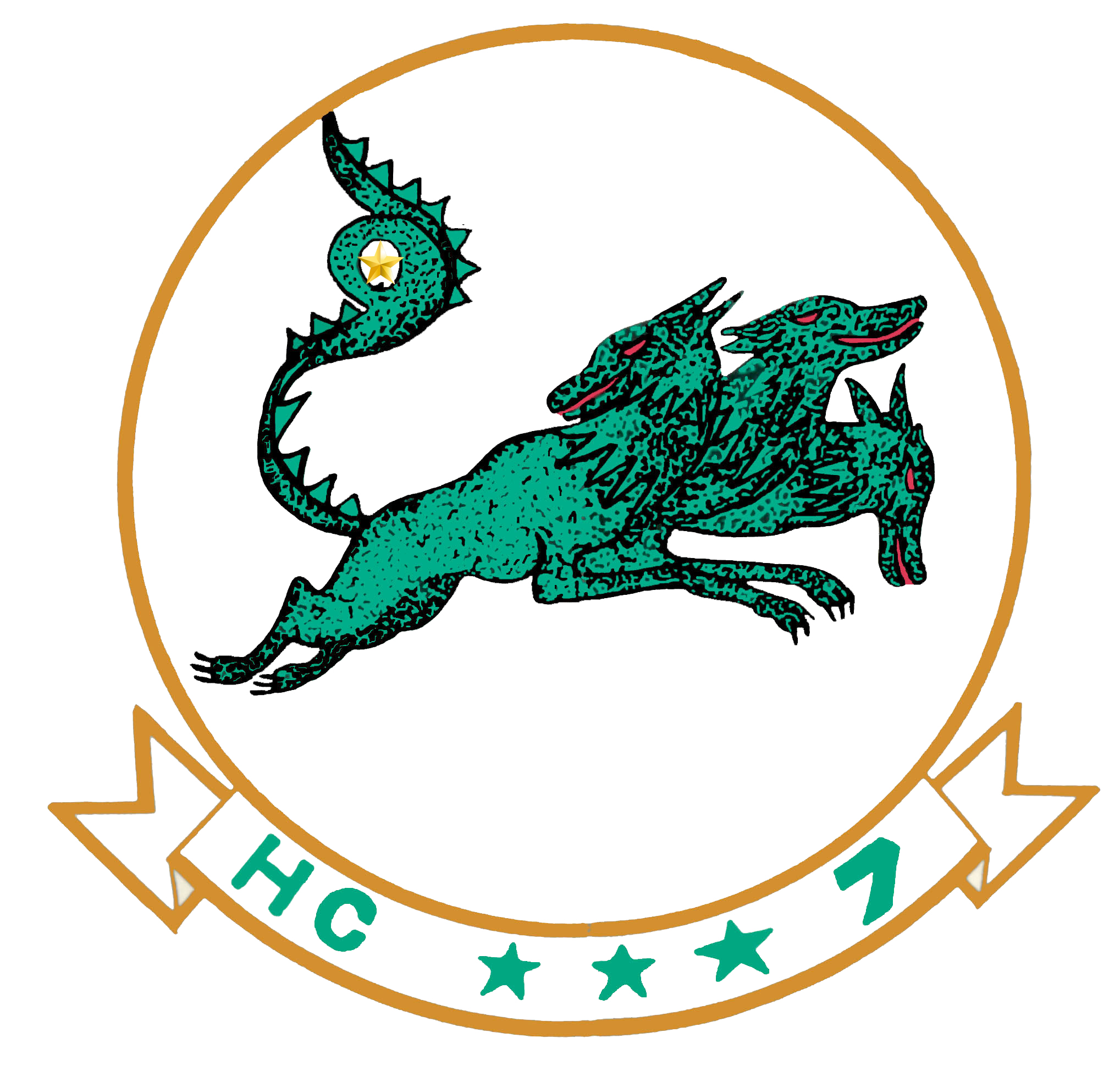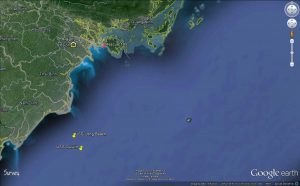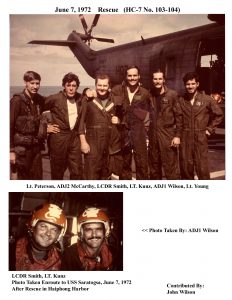
HC-7 RESCUE 103(1) 7-June-1972 (Wednesday)
HH-3A Sikorsky Seaking helo Det 110 Big Mother #66
USS Long Beach (CGN-9) Combat Day (2)
1.7 miles off North Vietnam coast
Water: 80⁰ Air: 90⁰ Wind: 8 knots Sea State: 2 ½-1 ft choppy
Pilot – LT Craig A. Peterson
Co-pilot – LTJG William D. Young
1st crew – ADJ-2 Timothy M. McCarthy
2nd crew – ADJ-1 John L. Wilson III
3rd crew – LCDR Edwin Towers – observer (O-in-C Op Thunderhead – code name “Black Beard”)
Alert received – 1345: Alert call relayed from Big Mother 67
Vehicle departed – 1345: 28 miles – Poor radio comm., UHF down in A/C
Arrived on scene – 1405 : Passed lead to BM 67 due to lack TACAN & one UHF
Located survivor – 1405: visual, locate smoke dropped by BM 67 locate survivors A/C & chute
Begin retrieval – 1408: swimmer dropped, close proximity mine fields – enemy fire
Ended retrieval – 1410: helo hoist – enemy fire
Survivor disembarked – 1445: Normal landing, USS Duluth (LPD-6)
RA-5C Vigilante 156616 (AC-601) (Comnch Trl 601) RVAH-1, USN,
USS Saratoga ( CVA-60)
Lt L. G. Kunz – RIO
The Atlantic Fleet carrier USS Saratoga arrived on the line on 18 May for its first and only tour of the war. With the arrival of the Saratoga the only available fleet carrier not to have served in Southeast Asia during the war was the USS John F Kennedy. The Saratoga lost its first aircraft on 7 June during a photographic reconnaissance sortie near Haiphong. A Vigilante was taking photographs of anchorages among the islands of Haiphong where foreign-registered merchant ships tied up before offloading supplies in the port. The aircraft began a pop-up maneuver at 3,000 feet to start a photo run when it received an indication of a nearby SAM launch. Lt Cdr Smith broke first to the left and then reversed his course at which point the SAM exploded as it hit the aircraft. The port engine lost power and had to be shut down and after Lt Cdr Smith headed out to sea and selected afterburner on the starboard engine, it also failed. The electrical power failed and the controls froze forcing the crew to eject about 15 miles southeast of Haiphong. A Sea King of HC-7 was directed towards the Vigilante and rescued the crew within minutes of their ejection. (5)
13:38, Aircraft 601 down in the water at 20⁰ 32’N 106⁰ 58’E Pilot LCDR Smith and RIO LT Kunz recovered by helo. Both crewman in satisfactory condition. 17:44, LCDR Smith and LT Kunz returned aboard by SAR helo. (14)
Statement of pilot – Peterson(3)
BIG MOTHER 66 launched from USS LONG BEACH (CGN-9) (13:00) (12), with a crew of five
enroute to a northern preposition point. BIG MOTHER 67 launched several minutes
later off the USS DULUTH (LPD-6). The crew of BIG MOTHER 66 had flown over
50 hours together in a two week period (Operation Thunderhead) and was well briefed and practiced for any contingency which might develop during a rescue.
Poor communications proved to be the most critical problem during the rescue operation. BIG MOTHER 66 had a failure of one UHF communication radio, and the SAE portion of their TACAN. Also, due to the distance from Red Crown and the fact that we were being controlled on helo common, transmission between the two was through relay aircraft; BIG MOTHER 67 and ANGEL 007. BIG MOTHER 67, who was several miles behind us and monitoring strike, on their secondary UHF, gave us our initial alert to a possible rescue (13:45). They also had a working TACAN for giving their position. For these reasons I slowed and passed the lead to BIG MOTHER 67 (14:05). Upon switching to frequency 282.8 MHZ BIG MOTHER 66 made initial communications with RESCAP and informed them. BIG MOTHER 67 had lead of the flight, Communications on guard was also held with the survivor.
Prior to arriving on the scene BIG MOTHER 67 briefed that he would pick up the northern most survivor and BIG MOTHER 66 would rescue the one to the southeast.’ Rescap warned both aircraft that hostile fire was coming from the beach. Both aircraft were aware of the proximity of the minefields and the beach. BIG MOTHER 67’s approach proved to be on the southern most survivor and several calls from the survivor in the water that he was at our 9 o’clock initially lead to some confusion as to the location of our man. BIG MOTHER 66 after a quick search on our port, realized that the survivor must be closer to the beach, and made a hard right turn and sighted a smoke dropped by BIG MOTHER 67 marking a position about 100 yards in front of our survivor.
The approach was made initially to the smoke, which necessitated a quick stop and loss of altitude when the survivor was spotted. (14:08) Our swimmer was dropped at 20 feet and 10 Kts approximately 20 feet from the survivor. The swimmer made the survivor almost immediately and gave the signal for pickup. The approach and pickup took approximately 20 seconds from this point (14:10). During the whole sequence, fire was taken from the beach, and exit from the area was made with haste. Survivor disembarked aboard USS Duluth (LPD-6) 14:45, spot one (13).

There are several points which became evident during and after the rescue which will be helpful at a later time.
1. Helo operations in the Gulf on Helo common 385.0 make difficult to control SAR vehicles. Having SAR common frequency available is almost a necessity.
2. Having two SAR HELOS available enhances everyone’s chances of survival not only due to cutting down dual pickup time but dividing fire from the beach and in this case spotting the enemy swift boat, calling fire and radio communications.
3. BIG MOTHER 66’s swimmer was injured slightly on water entry due to a survival radio which was on a lanyard attached to his swimmers harness. The radio snapped up and bruised several ribs. Suggest a pocket for this piece of gear be manufactured as part of the swimmers harness. Due to the possibility of aircraft under fire having to leave the area our crewmen feel that possession of a radio is a necessity.
4. BIG MOTHER 66 had aboard an observer who had flown a great number of missions with the crew. LCDR TOWERS was thoroughly familiar with the operation of the rescue hoist, weapons in the aircraft and our rescue tactics. The possession of a third crewmen proved to be invaluable in spotting the survivor and running the hoist and calling fire.
Statement of co-pilot Young: (3)
BIG MOTHER 66 was enroute to its preposition point when informed of two good chutes in the water. It was also known that the area was hot. We passed the lead to BIG MOTHER 67, because they had two good UHF radios and a good TACAN. We only had azimuth and no communications with Red Crown.
LT PETERSON started the SAR checklist, and I followed 67 toward Haiphong Harbor. Just prior to reaching the harbor, we switched to 282.8 and made contact with the on-Scene-Commander. He gave us a vector south of the harbor, and LT PETERSON spotted the A-7s circling the scene. The On-Scene-Commander informed us of the location of the two pilots in relation to each other, and we were to take the one southeast. As we approached the area, both aviators came up on the radio. BIG MOTHER 67 spotted both aviators and dropped a swimmer on the furthest one from the beach. He also dropped a smoke. At this time, our aviator was calling out “Nine o’clock”, and we then picked up the smoke at our three O’clock. I thought this was the RAN and I began an approach for a swimmer drop.
As we approached, ADJ2 McCARTHY saw the survivor two hundred yards short of the smoke. At the same time, LCDR TOWERS began calling fire from the beach. I decided to do a quick stop, I was able to get down to 20 feet and 10 knots, and I dropped the swimmer, ADJ1 WILSON. My first crewman said the swimmer was all right and had joined the survivor. I made a rapid turn to the right, saw the survivor and swimmer splashing in the water, and turned final with about a 50 yard straightaway. My first crewman talked me in over the survivor and LCDR TOWERS worked the hoist and trailed the sling in the water. We hovered at 30 feet for approximately 15 seconds and I got a clear to break hover. I got my airspeed up-and turned south to break-away from the area that was firing on us. Total time for the pickup was approximately two minutes from the time the swimmer went in the water.
LT Peterson had the crew prepared for this rescue by daily briefs and practice.
Complete crew coordination made the pick-up an extremely fast and simple one, even though we were under pressure from the fire on the beach and the proximity of the minefields. The crew reacted to these circumstances by concentrating on their particular job, and the mission became no tougher than a D-West pick-up.
Statement of First Crewman McCarthy: (3)
On June 8, 1972 we were flying north SAR. We were going to our station when we heard of two good chutes in the water. We proceeded to the scene by following BIG MOTHER 67 because we were having a bad time keeping comm. Once we got to the scene, we had a hard time finding our survivor. He was calling out nine O’clock but we couldn’t see him. Then we got a smoke at three O’clock. We turned and started an approach. The smoke was on our nose when I saw the survivor at 1:30 so I called out for a right turn and to slow down.
We came into a big flare and as we came over the survivor, I put out my swimmer. I felt we were high but not too high. (20 feet) Wilson (swimmer) came up after a bad fall and looked shaken; he got his breath and swam to the man. We did a racetrack and they were ready. I had briefed and practiced with LCDR TOWERS on hoist operations and he did an excellent job. We were over the swimmer and survivor about three seconds. Everyone did their job to the utmost of their ability and it was a professional rescue.
Statement of swimmer Wilson: (3)
As soon as the call was received that two pilots had ejected, I began to ready my equipment. I had my swim gear on beneath my flight suit, and was ready for water entry in a very short time. I got into position at the cargo door after test firing my M-60, and awaited the command to exit.
We came in over the survivor, and the first crewman tapped me off. I exited in the normal manner; left hand on my facemask, arm tucked into my side, and my right arm across my chest holding my harness, on my left side. (I hadn’t looked down at the water to estimate the aircrafts height, nor its forward speed during this period.) Prior to impact, I was watching the horizon, and saw it move almost vertical, indicating that I was going over on my side. Upon impact, I experienced an extreme pain in my left side, and the air was forced from my lungs. For a moment I was completely disorientated, and had a sensation of nausea. I then popped to the surface, gasping for air, which I could only take in short breaths. I signaled the helo with a wave and lay momentarily on my back, regaining my senses. A round, fired from the beach aided in bringing me around since I couldn’t swim to well, I located the survivor behind me about 30 feet or so, and proceeded to him, on my back.
I approached him from a few feet, face on, and noticed he had his survivor’s knife out and in his left hand. I asked him how he felt and he replied he was fine. I then told him to throw his knife away, which he did. Since I had one also, along with a shroud cutter, I didn’t want his knife
hanging loose on a string especially during the pick-up phase. I asked him where his parachute was, and he said he had ditched it. We both checked his koch fittings for risers and found them empty. Another round came over from the beach and I informed the (survivor that they were still firing at us.
At this time, the helo started inbound for the pick-up. I had attached my snap-link to the survivor’s “D” ring, which was sewn into his right shoulder strap. As the helo closed, we both splashed to give our position away. The cable came by, and with a few strokes, I reached the hook. I fastened the snap-link on my vest to the hook, and the helo crew pulled us up, on the run. The entire pick-up was quite fast, and very professional by the pilots and first Crewman.
One final point, that might be of some use during the training phase of Air crewman. A few moments before exiting the helo, I blew about two breaths of air, through the oral inflation tube, into my UDT vest. I feel this helped bring me back to the surface sooner, and kept me buoyant until I could regain control of-my breathing and senses.
After-Report of swimmer Wilson (Dec 2004 & June-2014 ): (10)
Received call for rescue – proceeded to Haiphong Harbor entrance. While searching for crew, the RIO was spotted while in a right hand turn at high speed. Pilot over shot the RIO, ordered swimmer dropped. 1st crewman tapped me OFF. I exited the aircraft at high speed and high altitude. After hook up with the survivor, the helo returned for a snatch pick-up on the run. I was treated on the USS Long Beach for lacerations to the left eyelid (stitched up) and cracked ribs (Left side), 75% pnuemothorax left lung. I was medivaced, the following day to Subic hospital. Returned to duty after 8 weeks of rehab.
• Took fire from shore batteries during entry to harbor, pickup and egress.
• Swimmer did not leave the aircraft early as published in report. (10)
1) Numbering as per HC-7 Rescue Log (accumulative rescue number)
2) HC-7 Rescue Log
3) HC-7 Det 110 Rescue report
4) Map – Google Earth
5) “Vietnam – Air Losses” By: Chris Hobson (with permission)
6) Loss aircraft location data provided by: W. Howard Plunkett (LtCol USAF, retired)
10) HC-7 History collection; Ron Milam – Historian
12) USS Long Beach – Deck Logs
13) USS Duluth – Deck Logs
14) USS Saratoga (CVA-60) – Deck Logs
(Compiled / written by: Ron Milam, HC-7 Historian – HC-7, 2-1969 to 7-1970, Det 108 & 113)
